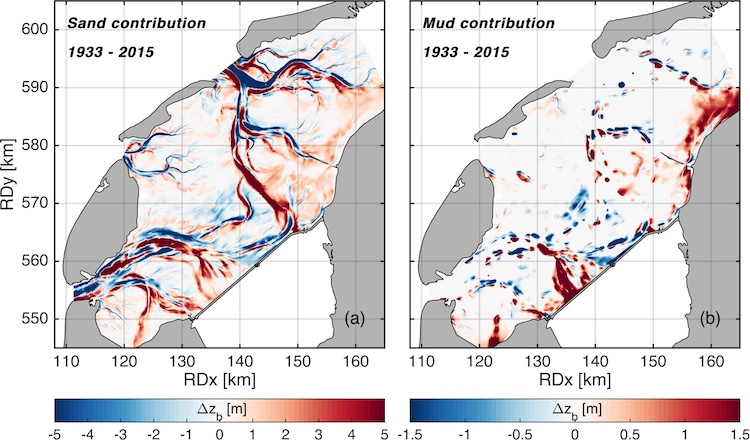A. Colina Alonso1,2*, D. S. van Maren1,2, E. P. L. Elias2, S. J. Holthuijsen.3, Z. B. Wang1,2
1 TU Delft
2 Deltares
3 NIOZ
*
Human interventions and climate change can severely influence the large-scale morphological development of tidal basins. This has implications on sediment management strategies, as well as on ecological and recreational purposes. Examples of heavily impacted tidal basins are those in the Western Dutch Wadden Sea: Closure of the Zuiderzee in 1932 still influences its morphodynamic development. Previous studies on the sediment budget did not differentiate between sand and mud fractions. However, understanding the contribution of both sediment types to the morphologic evolution is crucial for unravelling the processes responsible for the observed bathymetric changes.
This research presents a quantitative analysis of the post-closure sediment budgets, differentiating between sand and mud. Analysis of historical sediment composition data combined with bathymetry data revealed that the intervention caused a redistribution of sand and mud sedimentation. The responses of both sediment types differ spatially and temporally. The total infilling of the sandy basins over the last century was substantially caused by mud (~27 %, which is much larger than the average mud content in the bed). Initially, large mud volumes accreted in abandoned channels. At present, mud sedimentation along the mainland coast is still ongoing with nearly constant sedimentation rates over the past century, while the net import of sand significantly decreased over time and has been fluctuating around 0 over the last two decades.
SLR can be a major threat for the existence of the Wadden Sea with its current characteristics with extended tidal flats; these may drown if the sedimentation cannot to keep pace with SLR. We argue that for slow, gradual changes, both sand and mud sediments are likely to keep pace. For rapid changes — such as increased SLR rates — only the transport capacity of mud might be enough to compensate directly, as long as the sediment source remains sufficient. Consequently, mud contents in the basins would increase. The supply of mud is more than sufficient to keep pace with the current SLR rates.
This research shows the importance of distinguishing between the response of sandy and muddy sediments when analysing the morphodynamic impact of an intervention. We advocate collection of detailed sediment distribution data in the vicinity of large-scale past or future interventions, and use of this data in combination with available historic topographic data to understand the responses to and implications of interventions.

Figure 1: The contribution of sand (left panel) and mud (right panel) to the bed level changes of 1933-2015 inside the basins of the Western Dutch Wadden Sea (Colina Alonso, et al. (submitted)).
I. Surname1*, F.N. Another-Surname2 , Y. Next-Surname2
1 University Name, Country; 2 Organization Name, Country
* Corresponding author: mail.name@organization.org


